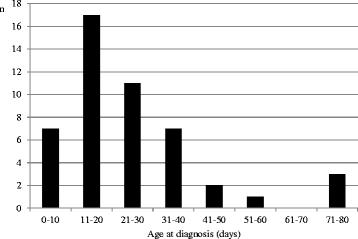Early diagnosis and care is achieved but should be improved in infants with Prader-Willi syndrome
- PMID: 28659150
- PMCID: PMC5490212
- DOI: 10.1186/s13023-017-0673-6
Early diagnosis and care is achieved but should be improved in infants with Prader-Willi syndrome
Abstract
Background: PWS is a severe neurodevelopmental genetic disorder now usually diagnosed in the neonatal period from hypotonia and feeding difficulties. Our study analyzed the birth incidence and care of infants with early diagnosis.
Methods: Data were collected on 61 infants with a molecular diagnosis of PWS born in 2012 and 2013 in France.
Results: Thirty-eight infants with PWS were born in 2013. The median age at diagnosis was 18 days. Birth incidence calculated for 2013 was 1/21,000 births. No case was diagnosed prenatally, despite 9 amniocenteses, including 4 for polyhydramnios. Five infants had delayed diagnosis, after 3 months of life. For 2 of them, the diagnosis was not suspected at birth and for 3, FISH analysis in the neonatal period was normal, with no further molecular studies. Ninety-three percent of the neonates were hospitalized, and 84% needed nasogastric tube feeding for a median of 38 days. Swallowing assessment was performed for 45%, at a median age of 10 days. Physiotherapy was started for 76% during hospitalization. Eighty percent of those diagnosed within the first 3 months were seen by a pediatric endocrinologist within the first week of life.
Conclusion: Our study is the first to assess the birth incidence of PWS in France, at 1/21,000 births. Some prenatal or neonatal cases remain undiagnosed because of unrecognized clinical signs and the inappropriate choice of the initial molecular test. We also underscore the need to optimize neonatal care of infants with PWS.
Keywords: Birth incidence; Delayed diagnosis; Early diagnosis; Neonatal care; Prader-Willi syndrome; Prenatal diagnosis.
Figures
References
-
- Prader A, Labhart A, Willi H. Ein Syndrom von Adipositas, Kleinwuchs, Kryptorchismus und Oligophrenie nach myotonieartigem Zustand im Neugeborenalter. Schweir Med Wschr. 1956;86:1260–1261.
-
- Bachere N, Diene G, Delagnes V, Molinas C, Moulin P, Tauber M. Early diagnosis and multidisciplinary care reduce the hospitalization time and duration of tube feeding and prevent early obesity in PWS infants. Horm Res. 2008;69:45–52. - PubMed
MeSH terms
LinkOut - more resources
Full Text Sources
Other Literature Sources
Medical



